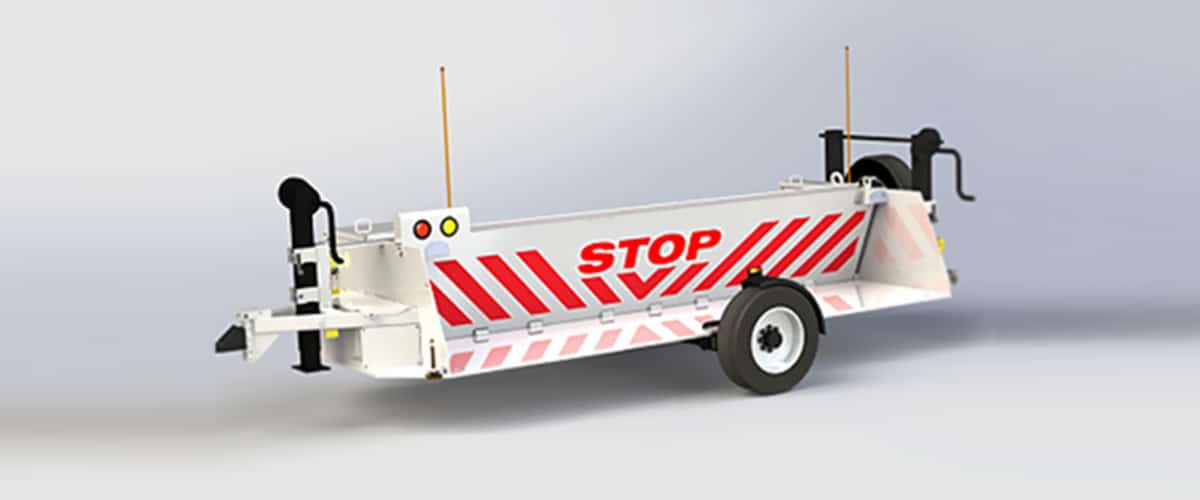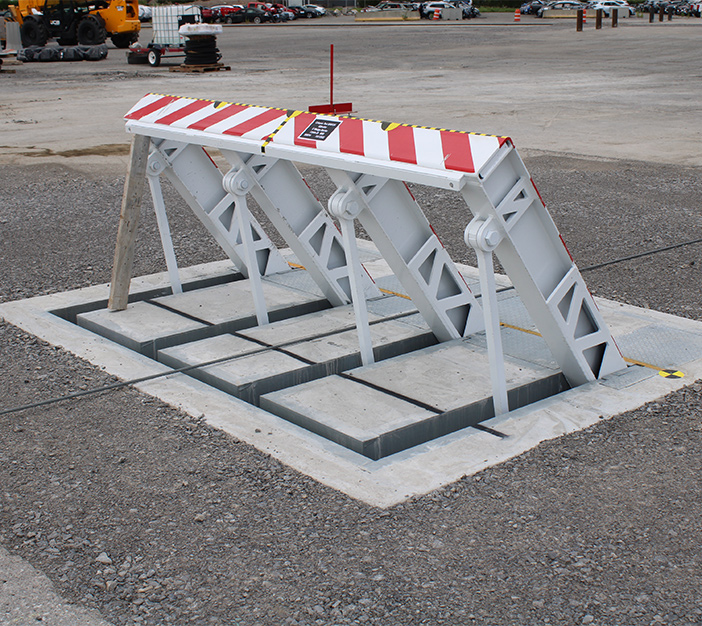Some Known Details About Wedge Barriers
All about Wedge Barriers
Table of ContentsWedge Barriers Things To Know Before You Get ThisNot known Details About Wedge Barriers


18 may be done more promptly, conveniently, and cost efficiently. FIG. In certain embodiments, the anchor 30 might be a steel frame consisting of plates, beams(e. g., I-beams ), and/or various other structures that are safeguarded within the foundation 14, which may be concrete. At the surface area 12, an upper side 28 of the support 30 might go to least partially revealed
, thus enabling the add-on of the barrier 10 to the anchor 30. g., threaded openings)in one or even more beam of lights or plates of the support 30 may be revealed to the surface 12. In this manner, bolts 32 or various other mechanical fasteners may be used to protect the barrier 10 to the support 30. As the barrier 10 is installed to the surface area 12 of the foundation 14, collection of debris and other product below the obstacle may be decreased, and components of the bather 10 might not be revealed to listed below quality environments. As suggested by referral character 52, the training mechanism 50 consists of components disposed underneath the wedge plate 16. The parts 52 beneath the wedge plate 16 may include an electromechanical actuator, a camera, one or even more web cam surface areas, and so forth. In addition, the lifting system 50 consists of a spring assembly 54
The spring pole 58 is paired to a web cam(e. g., web cam 80 revealed in FIG. 4) of the training mechanism 50. The springtimes 60 disposed about the springtime pole 58 are held in compression by springtime sustains 62, consisting of a dealt with springtime assistance 64. That is, the set spring support 64 is taken care of loved one to the foundation 14 and the rest of the bather 10.
The 20-Second Trick For Wedge Barriers
The staying force applied to
the cam webcam deploy release wedge plate 16 may might provided by an electromechanical actuator 84 or other actuator. The spring assembly 54 and the actuator 84(e. Wedge Barriers. g., electromechanical actuator)may run with each other to convert the web cam and lift the wedge plate 16.
As discussed over, the springtime setting up 54 applies a consistent pressure on the cam, while the electromechanical actuator might be regulated to exert a variable force on the webcam, consequently find this making it possible for the training and decreasing( i. e., releasing and withdrawing )of the wedge plate 16. In certain embodiments, the continuous force applied by the spring setting up 54 might be flexible. g., electromechanical actuator) is handicapped. As will be valued, the springtime setting up 54 might be covered and shielded from particles or various other aspects by a cover plate(e. g., cover plate 68 revealed in FIG. 4) that may be significantly flush with the elevated surface 38 of the foundation 14. As discussed above, in the released setting, the wedge plate 16 offers to block access or travel past the obstacle 10. As an example, the obstacle 10(e. g., the wedge plate 16 )may obstruct pedestrians or lorries from accessing a property or pathway. As gone over above, the barrier 10 is attached to the support 30 protected within the foundation 14,

front braces 71. As an outcome, the linkage assemblies 72 might pivot and rotate to make it possible for the collapse and extension of the link settings up 72 throughout retraction and release of the bather 10. The linkage assemblies 72 reason activity of the wedge plate 16 to be limited. If a vehicle is taking a trip towards the released wedge plate 16(e. For example, in one situation, the safety legs 86 might be expanded throughoutmaintenance of the barrier 10. When the safety legs 86 are released, the security legs 86 support the weight of the wedge plate 16 against the surface 12. Therefore, the training mechanism 50 might be shut off, serviced, removed, replaced, and so forth. FIG. 5 is partial viewpoint view of an embodiment of the surface-mounted wedge-style barrier 10, showing the cam 80 and the camera surface areas 82 of the training system 50. Particularly, 2 cam surface areas 82, which are described as reduced camera surfaces 83, are placed listed below the webcam 80. The reduced web cam surfaces Bonuses 83 might be dealt with to the surface 12 (e. For instance, the reduced cam surface areas 83 and the mounting plate 85 might develop a solitary piece that is safeguarded to the anchor 30 by screws or other mechanical bolts. Additionally, 2 cam surface areas 82, which are referred to as top web cam surfaces 87, are placed over the camera 80 and paired to (e. In other personifications, intervening layers or plates might be positioned in between the surface area 12 and the lower camera surfaces 83 and/or the wedge plate 16 and the top cam surfaces 87 As mentioned above, the camera
80 converts along the cam surface areas 82 when the wedge plate 16 is raised from the retracted setting to the deployed position. Furthermore, as stated above, the spring assembly 54 (see FIG. 3 )may provide a force acting on the camera 80 in the instructions 102 via spring rod 58, which might reduce the pressure the electromechanical actuator 84 is required to relate to the web cam 80 in order to actuate and lift the wedge plate 16. 1 )to the deployed setting(see FIG. 4). As revealed, the webcam 80 consists of track wheels 104(e. g., rollers), which call and convert along the web cam surface areas 82 during operation.